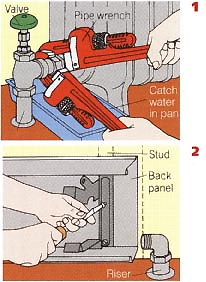Replacing a Radiator with a Convector
Metal convectors and radiators give up part of their warmth by radiation, but most of the heat comes from convection-air circulating past the hot metal. Generally found only in older systems, radiators are made of cast-iron tubing. Convectors, much lighter in weight, are either grilled cabinets or long, low baseboards. Inside they contain thin-wall copper or steel tubing surrounded by metal fins that increase the surface area. You can replace one or more radiators with convectors, as shown at right, but use dielectric fittings to connect pipes of different metals. Make certain the replacement convector’s output rating matches that of the radiator you’re removing.
Vent all the convectors or radiators in the system to ensure maximum efficiency. Never place anything on or in front of a convector or radiator; it could obstruct the airflow. If you paint a convector or radiator, use standard paint; metallic paint will substantially reduce the heat transfer. Dust also cuts down on efficiency; vacuum convectors and radiators regularly. Straighten bent con- vector fins with needle-nose pliers and be sure that the convector covers aren't bent or misaligned.

Above: Cast-iron radiator

Above: Upright convector

Above: Baseboard convector is low-lying, but still should
not be blocked.

1. Turn off system and let cool. Close feed valve and open radiator valves. Attach hose to boiler drain valve, open radiator vent and drain water. Use pipe wrenches (or propane torch, if soldered) to remove radiator.
2. Align baseboard convector with riser pipes and align con- vector’s back panel so it can be screwed directly into studs. Mark position for back-panel screw holes, drill pilot holes and screw into place.

3. Install the finned heating element on back panel. Clean riser threads using a wire brush; wipe with a clean rag and wrap with pipe tape. If riser is too far away, add needed extensions and fittings.
4. Make plumbing connections. Open inlet valve, attach convector cover, turn on water and flush out boiler. Close boiler drain valve; fill boiler. Turn system on and wait a bit; then vent system.
continued....
Shopping Smarter: A New Face in Radiators
The two most common complaints about radiators are that they take up too much floor space and that they’re less than attractive. Fortunately, there are radiators on the market that address both complaints. The wall mounted, vertical panel radiators (near right) are available in a wide variety of colors and sizes and are ideal for entry- ways and other rooms where floor space is limited. The European-style towel radiators (far right) provide both even heat and the luxury of warm, dry towels and bathrobes. These hydronic units can be used to replace fin-tube or cast-iron radiators and are compatible with most closed-loop, forced-hot-water heating systems. Electric versions are also available.

